University Report: Business System Specialism Literature Outline
VerifiedAdded on 2022/08/13
|7
|1390
|50
Report
AI Summary
This report presents a literature outline focusing on business system specialism, as required for a dissertation. The report begins with an overview of the main concept, defining business system specialism and its importance in organizations. It delves into the roles and responsibilities of business system specialists, including their work with computer technology, analysis of technological improvements, and acting as SMEs. The report also covers activities such as user acceptance testing (UAT) and system maintenance. The structure follows the assignment brief, including a main concept section, followed by key concepts and a reference table summarizing key articles. The report utilizes APA 6th edition referencing and aims to provide a clear and concise analysis of the topic within the word limit.
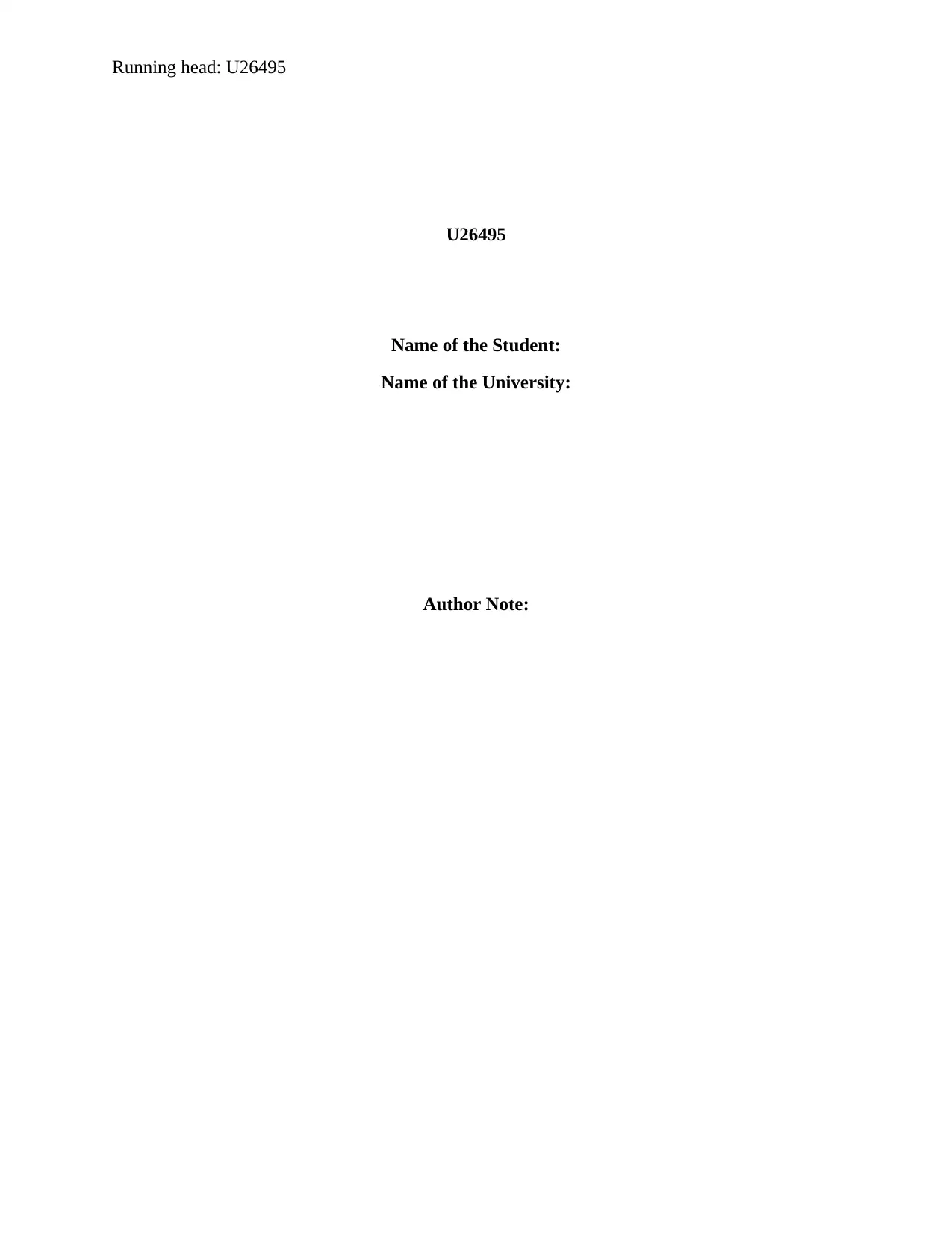
Running head: U26495
U26495
Name of the Student:
Name of the University:
Author Note:
U26495
Name of the Student:
Name of the University:
Author Note:
Paraphrase This Document
Need a fresh take? Get an instant paraphrase of this document with our AI Paraphraser
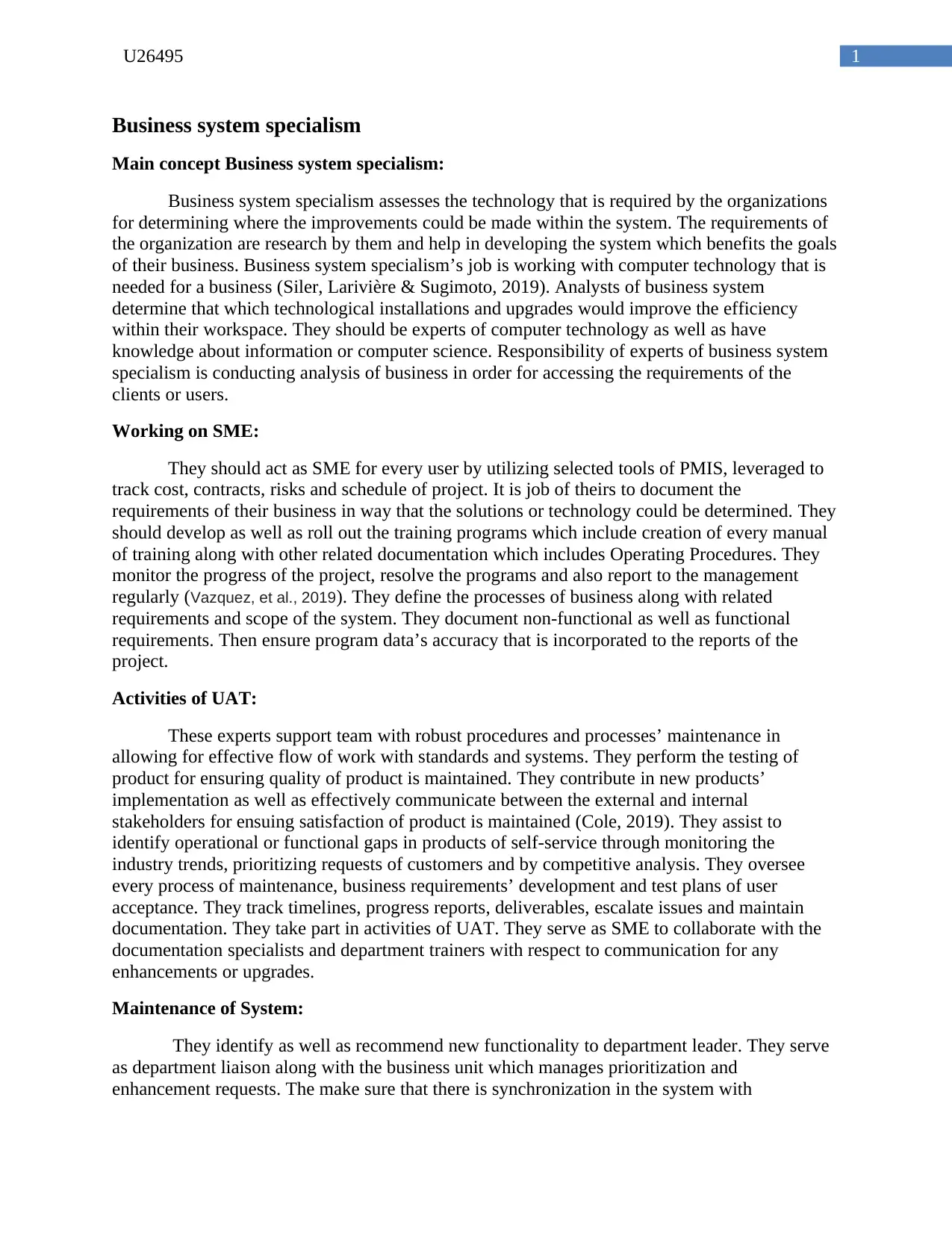
1U26495
Business system specialism
Main concept Business system specialism:
Business system specialism assesses the technology that is required by the organizations
for determining where the improvements could be made within the system. The requirements of
the organization are research by them and help in developing the system which benefits the goals
of their business. Business system specialism’s job is working with computer technology that is
needed for a business (Siler, Larivière & Sugimoto, 2019). Analysts of business system
determine that which technological installations and upgrades would improve the efficiency
within their workspace. They should be experts of computer technology as well as have
knowledge about information or computer science. Responsibility of experts of business system
specialism is conducting analysis of business in order for accessing the requirements of the
clients or users.
Working on SME:
They should act as SME for every user by utilizing selected tools of PMIS, leveraged to
track cost, contracts, risks and schedule of project. It is job of theirs to document the
requirements of their business in way that the solutions or technology could be determined. They
should develop as well as roll out the training programs which include creation of every manual
of training along with other related documentation which includes Operating Procedures. They
monitor the progress of the project, resolve the programs and also report to the management
regularly (Vazquez, et al., 2019). They define the processes of business along with related
requirements and scope of the system. They document non-functional as well as functional
requirements. Then ensure program data’s accuracy that is incorporated to the reports of the
project.
Activities of UAT:
These experts support team with robust procedures and processes’ maintenance in
allowing for effective flow of work with standards and systems. They perform the testing of
product for ensuring quality of product is maintained. They contribute in new products’
implementation as well as effectively communicate between the external and internal
stakeholders for ensuing satisfaction of product is maintained (Cole, 2019). They assist to
identify operational or functional gaps in products of self-service through monitoring the
industry trends, prioritizing requests of customers and by competitive analysis. They oversee
every process of maintenance, business requirements’ development and test plans of user
acceptance. They track timelines, progress reports, deliverables, escalate issues and maintain
documentation. They take part in activities of UAT. They serve as SME to collaborate with the
documentation specialists and department trainers with respect to communication for any
enhancements or upgrades.
Maintenance of System:
They identify as well as recommend new functionality to department leader. They serve
as department liaison along with the business unit which manages prioritization and
enhancement requests. The make sure that there is synchronization in the system with
Business system specialism
Main concept Business system specialism:
Business system specialism assesses the technology that is required by the organizations
for determining where the improvements could be made within the system. The requirements of
the organization are research by them and help in developing the system which benefits the goals
of their business. Business system specialism’s job is working with computer technology that is
needed for a business (Siler, Larivière & Sugimoto, 2019). Analysts of business system
determine that which technological installations and upgrades would improve the efficiency
within their workspace. They should be experts of computer technology as well as have
knowledge about information or computer science. Responsibility of experts of business system
specialism is conducting analysis of business in order for accessing the requirements of the
clients or users.
Working on SME:
They should act as SME for every user by utilizing selected tools of PMIS, leveraged to
track cost, contracts, risks and schedule of project. It is job of theirs to document the
requirements of their business in way that the solutions or technology could be determined. They
should develop as well as roll out the training programs which include creation of every manual
of training along with other related documentation which includes Operating Procedures. They
monitor the progress of the project, resolve the programs and also report to the management
regularly (Vazquez, et al., 2019). They define the processes of business along with related
requirements and scope of the system. They document non-functional as well as functional
requirements. Then ensure program data’s accuracy that is incorporated to the reports of the
project.
Activities of UAT:
These experts support team with robust procedures and processes’ maintenance in
allowing for effective flow of work with standards and systems. They perform the testing of
product for ensuring quality of product is maintained. They contribute in new products’
implementation as well as effectively communicate between the external and internal
stakeholders for ensuing satisfaction of product is maintained (Cole, 2019). They assist to
identify operational or functional gaps in products of self-service through monitoring the
industry trends, prioritizing requests of customers and by competitive analysis. They oversee
every process of maintenance, business requirements’ development and test plans of user
acceptance. They track timelines, progress reports, deliverables, escalate issues and maintain
documentation. They take part in activities of UAT. They serve as SME to collaborate with the
documentation specialists and department trainers with respect to communication for any
enhancements or upgrades.
Maintenance of System:
They identify as well as recommend new functionality to department leader. They serve
as department liaison along with the business unit which manages prioritization and
enhancement requests. The make sure that there is synchronization in the system with
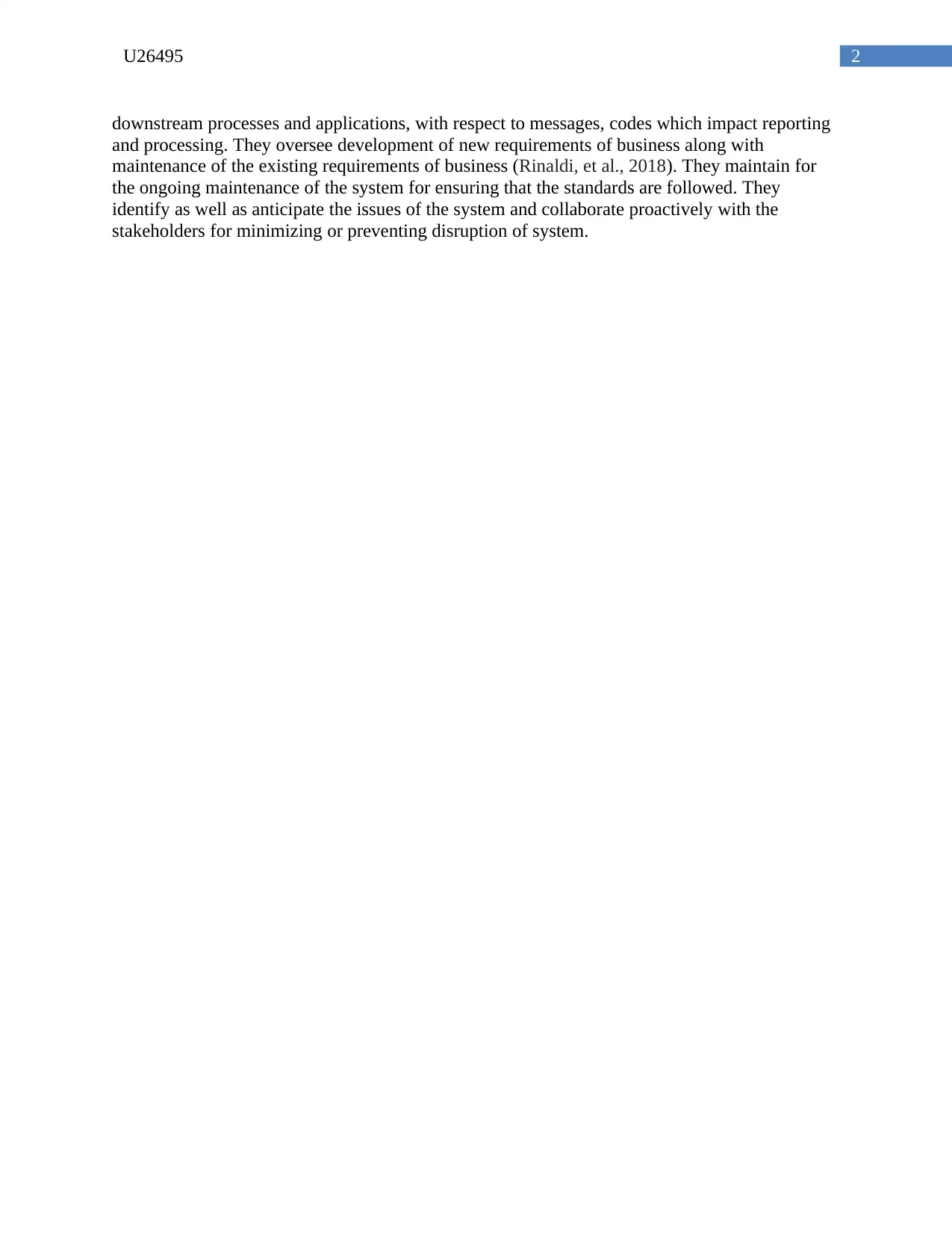
2U26495
downstream processes and applications, with respect to messages, codes which impact reporting
and processing. They oversee development of new requirements of business along with
maintenance of the existing requirements of business (Rinaldi, et al., 2018). They maintain for
the ongoing maintenance of the system for ensuring that the standards are followed. They
identify as well as anticipate the issues of the system and collaborate proactively with the
stakeholders for minimizing or preventing disruption of system.
downstream processes and applications, with respect to messages, codes which impact reporting
and processing. They oversee development of new requirements of business along with
maintenance of the existing requirements of business (Rinaldi, et al., 2018). They maintain for
the ongoing maintenance of the system for ensuring that the standards are followed. They
identify as well as anticipate the issues of the system and collaborate proactively with the
stakeholders for minimizing or preventing disruption of system.
⊘ This is a preview!⊘
Do you want full access?
Subscribe today to unlock all pages.

Trusted by 1+ million students worldwide
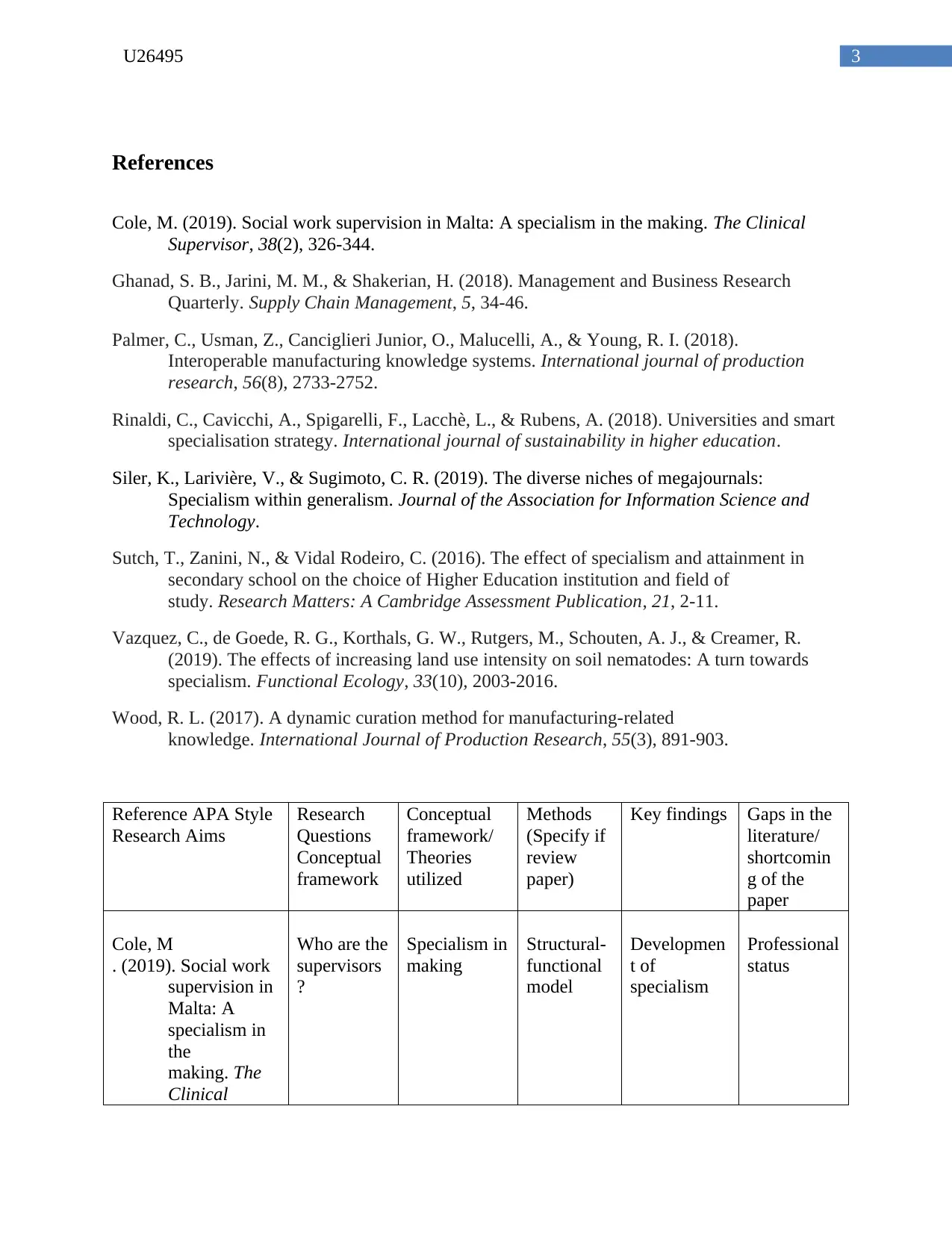
3U26495
References
Cole, M. (2019). Social work supervision in Malta: A specialism in the making. The Clinical
Supervisor, 38(2), 326-344.
Ghanad, S. B., Jarini, M. M., & Shakerian, H. (2018). Management and Business Research
Quarterly. Supply Chain Management, 5, 34-46.
Palmer, C., Usman, Z., Canciglieri Junior, O., Malucelli, A., & Young, R. I. (2018).
Interoperable manufacturing knowledge systems. International journal of production
research, 56(8), 2733-2752.
Rinaldi, C., Cavicchi, A., Spigarelli, F., Lacchè, L., & Rubens, A. (2018). Universities and smart
specialisation strategy. International journal of sustainability in higher education.
Siler, K., Larivière, V., & Sugimoto, C. R. (2019). The diverse niches of megajournals:
Specialism within generalism. Journal of the Association for Information Science and
Technology.
Sutch, T., Zanini, N., & Vidal Rodeiro, C. (2016). The effect of specialism and attainment in
secondary school on the choice of Higher Education institution and field of
study. Research Matters: A Cambridge Assessment Publication, 21, 2-11.
Vazquez, C., de Goede, R. G., Korthals, G. W., Rutgers, M., Schouten, A. J., & Creamer, R.
(2019). The effects of increasing land use intensity on soil nematodes: A turn towards
specialism. Functional Ecology, 33(10), 2003-2016.
Wood, R. L. (2017). A dynamic curation method for manufacturing-related
knowledge. International Journal of Production Research, 55(3), 891-903.
Reference APA Style
Research Aims
Research
Questions
Conceptual
framework
Conceptual
framework/
Theories
utilized
Methods
(Specify if
review
paper)
Key findings Gaps in the
literature/
shortcomin
g of the
paper
Cole, M
. (2019). Social work
supervision in
Malta: A
specialism in
the
making. The
Clinical
Who are the
supervisors
?
Specialism in
making
Structural-
functional
model
Developmen
t of
specialism
Professional
status
References
Cole, M. (2019). Social work supervision in Malta: A specialism in the making. The Clinical
Supervisor, 38(2), 326-344.
Ghanad, S. B., Jarini, M. M., & Shakerian, H. (2018). Management and Business Research
Quarterly. Supply Chain Management, 5, 34-46.
Palmer, C., Usman, Z., Canciglieri Junior, O., Malucelli, A., & Young, R. I. (2018).
Interoperable manufacturing knowledge systems. International journal of production
research, 56(8), 2733-2752.
Rinaldi, C., Cavicchi, A., Spigarelli, F., Lacchè, L., & Rubens, A. (2018). Universities and smart
specialisation strategy. International journal of sustainability in higher education.
Siler, K., Larivière, V., & Sugimoto, C. R. (2019). The diverse niches of megajournals:
Specialism within generalism. Journal of the Association for Information Science and
Technology.
Sutch, T., Zanini, N., & Vidal Rodeiro, C. (2016). The effect of specialism and attainment in
secondary school on the choice of Higher Education institution and field of
study. Research Matters: A Cambridge Assessment Publication, 21, 2-11.
Vazquez, C., de Goede, R. G., Korthals, G. W., Rutgers, M., Schouten, A. J., & Creamer, R.
(2019). The effects of increasing land use intensity on soil nematodes: A turn towards
specialism. Functional Ecology, 33(10), 2003-2016.
Wood, R. L. (2017). A dynamic curation method for manufacturing-related
knowledge. International Journal of Production Research, 55(3), 891-903.
Reference APA Style
Research Aims
Research
Questions
Conceptual
framework
Conceptual
framework/
Theories
utilized
Methods
(Specify if
review
paper)
Key findings Gaps in the
literature/
shortcomin
g of the
paper
Cole, M
. (2019). Social work
supervision in
Malta: A
specialism in
the
making. The
Clinical
Who are the
supervisors
?
Specialism in
making
Structural-
functional
model
Developmen
t of
specialism
Professional
status
Paraphrase This Document
Need a fresh take? Get an instant paraphrase of this document with our AI Paraphraser

4U26495
Supervisor, 38
(2), 326-344.
Siler, K., Larivière,
V., &
Sugimoto, C.
R. (2019). The
diverse niches
of
megajournals:
Specialism
within
generalism. Jo
urnal of the
Association
for
Information
Science and
Technology.
What are
disciplinary
niches of
specialism?
Competitive
ecology
Examinatio
n of output
Specialism
has different
niches
Citation
Impact
Vazquez, C., de Goede,
R. G., Korthals,
G. W., Rutgers,
M., Schouten,
A. J., &
Creamer, R.
(2019). The
effects of
increasing land
use intensity on
soil nematodes:
A turn towards
specialism. Fun
ctional
Ecology, 33(10)
, 2003-2016.
Niche width Nematode
diversity
Data set Data
integration
Effects of
intensity of
specialism
Sutch, T., Zanini, N., &
Vidal Rodeiro,
C. (2016). The
effect of
specialism and
attainment in
secondary
school on the
Growth of
specialism
Logistic
regression
model
Data and
variables
Descriptive
analyses
Subject area
Supervisor, 38
(2), 326-344.
Siler, K., Larivière,
V., &
Sugimoto, C.
R. (2019). The
diverse niches
of
megajournals:
Specialism
within
generalism. Jo
urnal of the
Association
for
Information
Science and
Technology.
What are
disciplinary
niches of
specialism?
Competitive
ecology
Examinatio
n of output
Specialism
has different
niches
Citation
Impact
Vazquez, C., de Goede,
R. G., Korthals,
G. W., Rutgers,
M., Schouten,
A. J., &
Creamer, R.
(2019). The
effects of
increasing land
use intensity on
soil nematodes:
A turn towards
specialism. Fun
ctional
Ecology, 33(10)
, 2003-2016.
Niche width Nematode
diversity
Data set Data
integration
Effects of
intensity of
specialism
Sutch, T., Zanini, N., &
Vidal Rodeiro,
C. (2016). The
effect of
specialism and
attainment in
secondary
school on the
Growth of
specialism
Logistic
regression
model
Data and
variables
Descriptive
analyses
Subject area

5U26495
choice of
Higher
Education
institution and
field of
study. Researc
h Matters: A
Cambridge
Assessment
Publication, 21,
2-11.
Wood, R. L. (2017). A
dynamic
curation method
for
manufacturing-
related
knowledge. Inte
rnational
Journal of
Production
Research, 55(3)
, 891-903.
Discriminat
ion of
knowledge
Knowledge
management
system
Dynamic
curation
Specialisms
overlap
paradigms
Dynamic
manufacturi
ng
Ghanad, S. B., Jarini,
M. M., &
Shakerian, H.
(2018).
Management
and Business
Research
Quarterly. Supp
ly Chain
Management, 5
, 34-46.
Structural
modeling
ERP system Questionna
ire
General
model fitting
evaluation
Construct
validity
Rinaldi, C., Cavicchi, A.,
Spigarelli, F.,
Lacchè, L., &
Rubens, A.
(2018).
Universities and
smart
specialisation
strategy. Intern
ational journal
of sustainability
in higher
education.
Role of
specialism
Contributions
of specialism
Mission
activities
Role of
specialism
Originality
Palmer, C., Usman, Z.,
Canciglieri
Junior, O.,
Malucelli, A., &
Young, R. I.
Importance
of the
semantic
technologie
ICT
perspective
Ontology
approach
Manufacturi
ng
knowledge
systems
Specialisati
on
choice of
Higher
Education
institution and
field of
study. Researc
h Matters: A
Cambridge
Assessment
Publication, 21,
2-11.
Wood, R. L. (2017). A
dynamic
curation method
for
manufacturing-
related
knowledge. Inte
rnational
Journal of
Production
Research, 55(3)
, 891-903.
Discriminat
ion of
knowledge
Knowledge
management
system
Dynamic
curation
Specialisms
overlap
paradigms
Dynamic
manufacturi
ng
Ghanad, S. B., Jarini,
M. M., &
Shakerian, H.
(2018).
Management
and Business
Research
Quarterly. Supp
ly Chain
Management, 5
, 34-46.
Structural
modeling
ERP system Questionna
ire
General
model fitting
evaluation
Construct
validity
Rinaldi, C., Cavicchi, A.,
Spigarelli, F.,
Lacchè, L., &
Rubens, A.
(2018).
Universities and
smart
specialisation
strategy. Intern
ational journal
of sustainability
in higher
education.
Role of
specialism
Contributions
of specialism
Mission
activities
Role of
specialism
Originality
Palmer, C., Usman, Z.,
Canciglieri
Junior, O.,
Malucelli, A., &
Young, R. I.
Importance
of the
semantic
technologie
ICT
perspective
Ontology
approach
Manufacturi
ng
knowledge
systems
Specialisati
on
⊘ This is a preview!⊘
Do you want full access?
Subscribe today to unlock all pages.

Trusted by 1+ million students worldwide
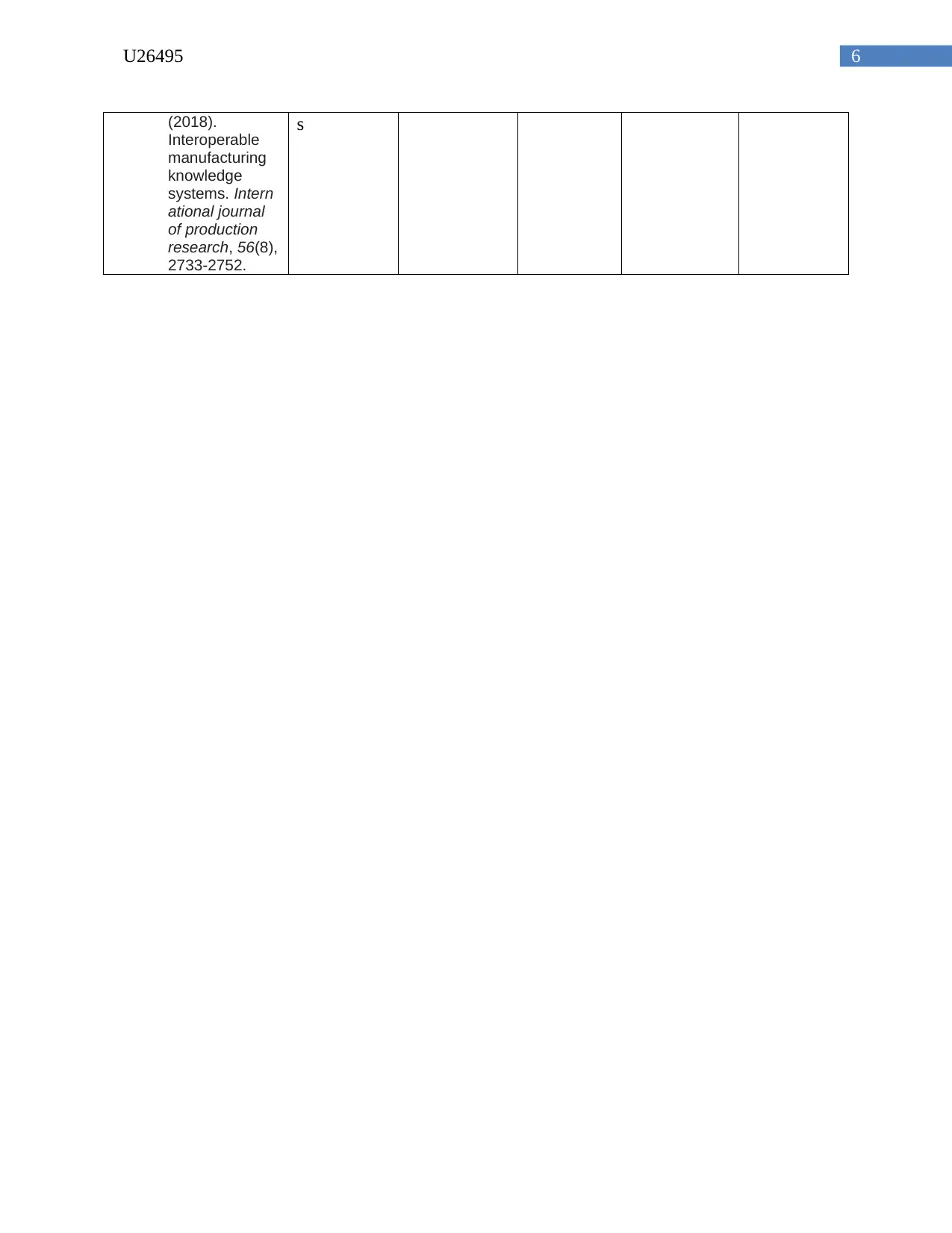
6U26495
(2018).
Interoperable
manufacturing
knowledge
systems. Intern
ational journal
of production
research, 56(8),
2733-2752.
s
(2018).
Interoperable
manufacturing
knowledge
systems. Intern
ational journal
of production
research, 56(8),
2733-2752.
s
1 out of 7
Related Documents
Your All-in-One AI-Powered Toolkit for Academic Success.
+13062052269
info@desklib.com
Available 24*7 on WhatsApp / Email
![[object Object]](/_next/static/media/star-bottom.7253800d.svg)
Unlock your academic potential
Copyright © 2020–2025 A2Z Services. All Rights Reserved. Developed and managed by ZUCOL.




